Royal Viking Sea, Royal Viking Star and Royal Viking Sky
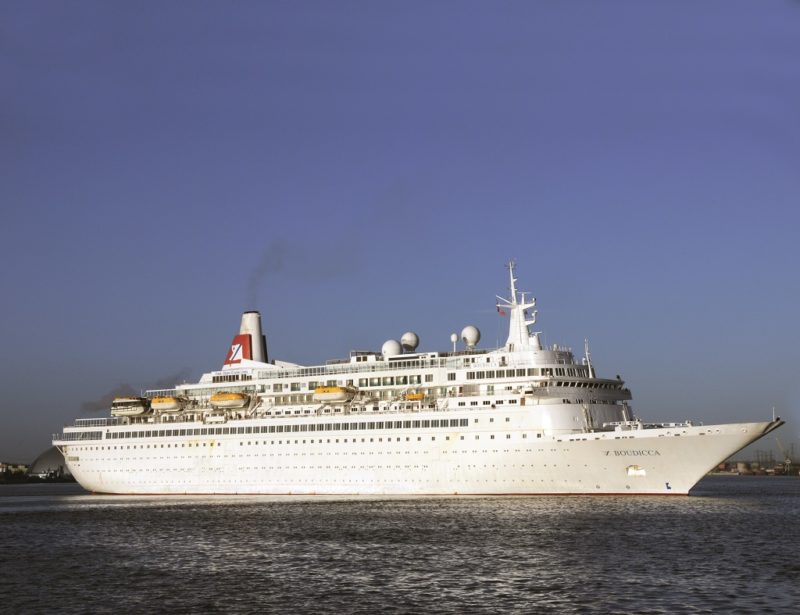
Although ordered fifty years ago, this trio of five star luxury purpose built cruise ships kept their deserved place in the crowded world of new and bigger cruise ships until recently. The trio were products of the early 1970s from the O/Y Wartsila yard at Helsinki, builders of many famous cruise ships. They were completed for the new Royal Viking Line, one of five new cruise companies at this time, the others being Carnival Cruises, Royal Caribbean Cruise Line (RCCL), Princess Cruises and Norwegian Cruise Line (NCL). Royal Viking Line had been set up jointly in 1970 by three Norwegian shipping companies, Bergen Line, a well known ferry and passenger ship owner with much cruising experience, Nordenfjeldske of Trondheim, well known on the Hurtigruten service to the North Cape of Norway from Bergen, and A.F. Klaveness of Lysaker (Oslo), a well-known tanker and cargo ship owner since 1898.
The three companies each ordered a twin screw cruise ship of 21,850 grt from the Wartsila yard in Helsinki at a cost of $22.5 million each, and they were completed as Royal Viking Star in June 1972 (the Bergen Line ship), Royal Viking Sky in June 1973 (the Nordenfjeldske ship), and Royal Viking Sea in November 1973 (the Klaveness ship). A.F. Klaveness withdrew from the consortium in 1975, leaving Royal Viking Sea jointly owned by Bergen Line and Nordenfjeldske until both sold out to the Kloster family in 1984. Royal Viking Line had Warren Titus, with previous cruising experience at American President Lines and P&O, as Company President and Marketing Director at their San Francisco headquarters.
However, the influence of Warren Titus extended beyond this into every aspect of shipboard design and décor, which became a standard for cruising good taste. As a consequence, the three worldwide cruise ships built up a good repeat business especially with their older customers, who liked the high standard of service. The brand offered continual new and imaginative destinations in a comprehensive cruise atlas or brochure, including Round the World cruises of over 100 days duration from New York, Alaskan cruises from Vancouver, short New England and St. Lawrence cruises from New York, Caribbean and South American cruises from Miami, Mediterranean and Black Sea cruises from Venice and Piraeus, Baltic and North Cape cruises from Copenhagen, and Round Britain cruises from Southampton.
As completed, they had sharply raked bows with excellent open deck Boat Decks for sun bathing and exercise, and their tall funnels consisted of three sections with the engine exhaust pipes in the taller central section, and the red Royal Viking ‘lyre’ logo on the white casing of the outer sections. They had accommodation for only 539 passengers in cabins located on eight passenger decks, named as Sun, Sky, Promenade, Scandinavia, Atlantic, Pacific, Mediterranean and Sauna decks. There were also 32 de-luxe three berth cabins consisting of a bedroom, sitting room and bathroom, and all passengers enjoyed the public rooms of the Dining Room, Main Lounge, Observation Lounge above the bridge with excellent views, Sky Bar, Night Club and Lido Bar. The ships were air conditioned throughout, and there was an outdoor pool, gymnasium, sauna, a double height theatre extending over two decks, library, gift shop, beauty salon and barber shop. Royal Viking Sea, the Klaveness ship, was the last to be completed and arrived in the Tyne on 25th November 1973 to embark passengers on her maiden voyage on the Tyne to Bergen route, temporarily replacing Leda during her overhaul.
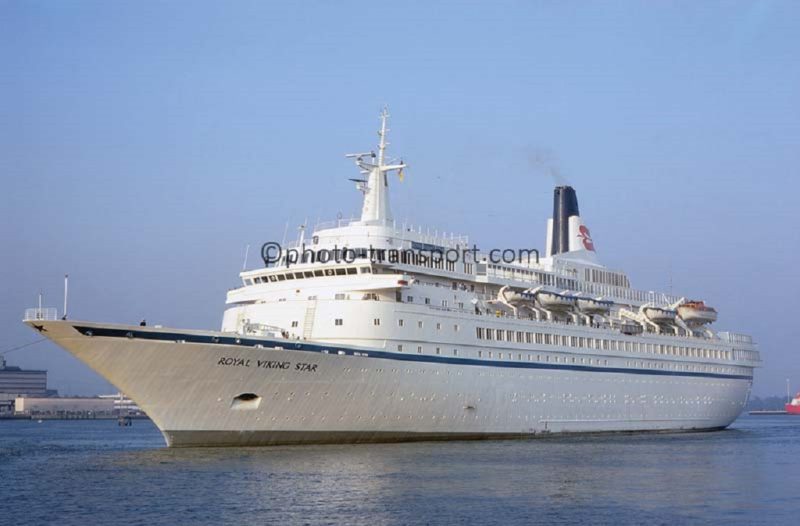
This voyage was a North Sea ‘shakedown’ voyage to test her facilities and her new crew. Royal Viking Star differed from her two sisters in that she was two feet shorter in length and featured a chapel just forward of the theatre, which was not included in her two sisters, and there were minor differences in the lounges and library. She then began her long career of top of the range luxury cruises, which were later published by Royal Viking Line in book form as ‘Voyages of the Royal Vikings’, a coffee table book of beautiful colour photographs grouped according to geographic cruise areas. The Royal Viking Line brochure was packed with lengthy and diverse cruises, and gained the nickname of ‘The Atlas’. Royal Viking Sky and Royal Viking Star became the first sister ships to transit the Panama Canal simultaneously in the opposite directions on 1st May 1976, the Sky sailing westwards and the Star eastwards.
The trio were lengthened by a 93 feet long prefabricated ‘midships section at the A.G. Weser yard at Bremerhaven during 1981/82/83 during a three month refit in an effort to attract more younger customers by raising capacity from 550 to 750 passengers. The mid-section that was inserted mainly consisted of cabins, but aft of the Observation Lounge a new lounge and nine penthouse suites with balconies were added and were named after destinations. The size of the Dining Room was also doubled and now occupied nearly one half of one deck in order to maintain single seating dining. The trio were now of 28,220 gt and in my opinion, were even more handsome than when built, the longer passenger accommodation being balanced by their highly raked bows and tall, elegant funnels. This lengthening was a big gamble by Chief Executive Torstein Hagen, as the Royal Viking Line mainly depended on repeat business, a gamble that didn’t pay off.
Their valued repeat business was gradually eroded as many loyal passengers felt that the trio had lost their intimate appeal, and had lost out to the many new cruise ships that entered service during the 1980s. A new generation of small five star luxury cruise ships such as the ‘Sea Goddesses’ and similar ‘super yachts’ stole many of their discerning cruise clientele.
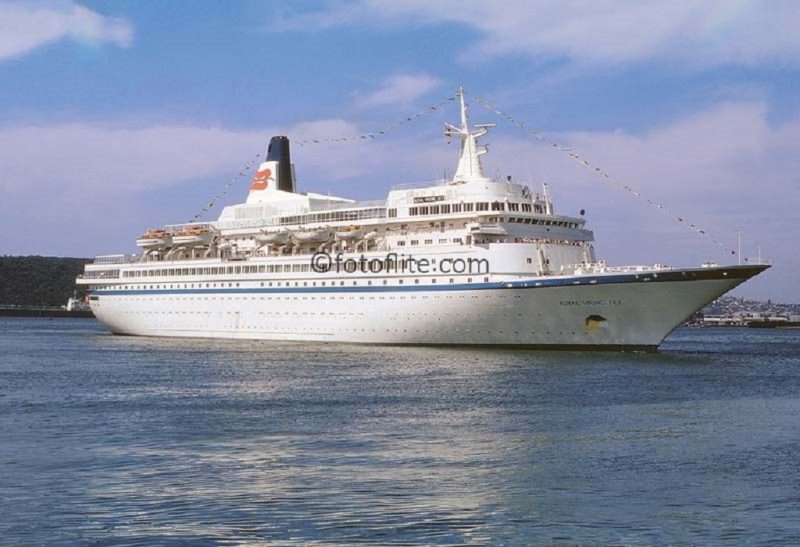
On 29th November 1983, Royal Viking Sea rescued 151 survivors from the Indian ferry Dojo, who had been adrift for eleven days in the Celebes Sea. However, Royal Viking Sky suffered a very bad fire during a cruise and arrived at Bremerhaven for repairs on 18th May 1984. As a result, the cash flow situation deteriorated alarmingly, and Bergen Line and Nordenfjeldske sold the trio during that month to Kloster’s NCL (Norwegian Caribbean Line) for around $250 million, with Warren Titus leaving the company during the following year.
However, Royal Viking Line was operated quite separately from NCL by Kloster, with the Royal Viking trio continuing to make long, luxurious worldwide cruises. The only indication of amalgamation of the two distinct fleets was the transfer of crew members across the two fleets, the headquarters of Royal Viking Line having been moved to Miami in 1986. The addition of Royal Viking Line to NCL allowed Kloster to operate cruises beyond the Caribbean for the first time. In recognition of this expansion, NCL changed its name in 1987 to Norwegian Cruise Line and in the following year Royal Viking Line was placed under NCL management although continuing to operate as a separate brand.
The highly luxurious, award winning five star cruise ship Royal Viking Sun of 37,845 gt was commissioned during 1988, and the mini cruise ship Royal Viking Queen of 9,961 gt during 1992. Royal Viking Sky provided a total of six summer cruises from Southampton each year during her last two years under her original name in 1989/90. She was based at Copenhagen for the rest of her summer schedule for Baltic cruising, and returned to Southampton via a leisurely cruise around the UK and Ireland before being repositioned to the Mediterranean for fly cruises. Royal Viking Star and Royal Viking Sky were renamed in 1991 as Westward and Sunward respectively for NCL, with Royal Viking Sea renamed Royal Odyssey at the same time for the Royal Cruise Line brand also operated by Kloster, with Westward then renamed as Star Odyssey in 1994. Sunward was sold to Birka Line of Finland in 1992 as Birka Queen for Baltic cruising, and was then chartered for three years to Princess Cruises from June 1993 as Golden Princess. Birka Line also operated their twin screw ferry Birka Princess of 21,484 gt at this time. She had been completed at Helsinki in 1986 and had accommodation for 1,400 people on their Finland to Sweden service.
However, the imbalance of the luxury Royal Viking Line within Kloster’s other budget priced cruise companies proved too much in the end, and in 1994 the Royal Viking Line name and Royal Viking Sun were sold to Cunard Line for $170 million, with two of the Royal Viking trio then operating for Royal Cruise Line, a Kloster company. Royal Star Line was then closed down in 1995, and the Royal Viking pair were then transferred to NCL, allowing NCL to offer European cruises for the first time. During this time, the Kloster family lost control of NCL, and Kloster Cruises was renamed as NCL Holdings.
On 1st October 1996, Star Odyssey (ex Royal Viking Star) was delivered to Fred. Olsen Line and renamed as Black Watch, and the former Royal Viking Sky was sold to Star Cruises of Malaysia for $50 million and renamed Superstar Capricorn during the same year. Star Cruises had been formed in 1993 by Singapore entrepreneur Eddy Lee for the fast growing Asian cruise market from Singapore, particularly up the west coast of Malaysia to Phuket and the other Thai islands. Superstar Capricorn became an overnight casino ship at New York on charter to Manhattan Cruises on 20th March 1998, replacing Edinburgh Castle, ex Eugenio C of Costa Line. Superstar Capricorn then cruised from Keelung (Taiwan) north to the Japanese islands including Okinawa, and was then delivered on 5th September 1998 to Hyundai Merchant Marine for a four year charter and renamed as Hyundai Kumgang for cruising out of Donghae on the east coast of Korea.
Royal Odyssey, ex Royal Viking Sea, was renamed as Norwegian Star in late May 1997 by NCL for their new year round Caribbean cruise service from Houston. She experienced mechanical problems later that year when her air conditioning failed during two cruises in October, followed by defective plumbing and an engine breakdown on her Christmas cruise, forcing some passengers to sleep on deck. She was repaired at Houston and continued to operate from that port until refitted in October 1998 in readiness for a series of cruises in Australian and New Zealand waters that began two months later for Norwegian Capricorn Lines, a joint venture between NCL and Star Cruises.
At the start of the new Millennium, Norwegian Star was still cruising in Australian waters, Black Watch was cruising in the Caribbean, and Hyundai Kumgang was still cruising from Donghae in Korea. The fast growing Star Cruises then took over NCL in February 2000, and Superstar Capricorn regained her name at the end of the Hyundai charter in May 2002 and was then based at Laem Chabang south of Bangkok for Gulf of Thailand cruising. She was then sold in 2004 to Grand Latino de Navegacao S.A. (Martinoli S.A., Panama) and renamed Grand Latino for charter to the Spanish cruise company Iberojet.
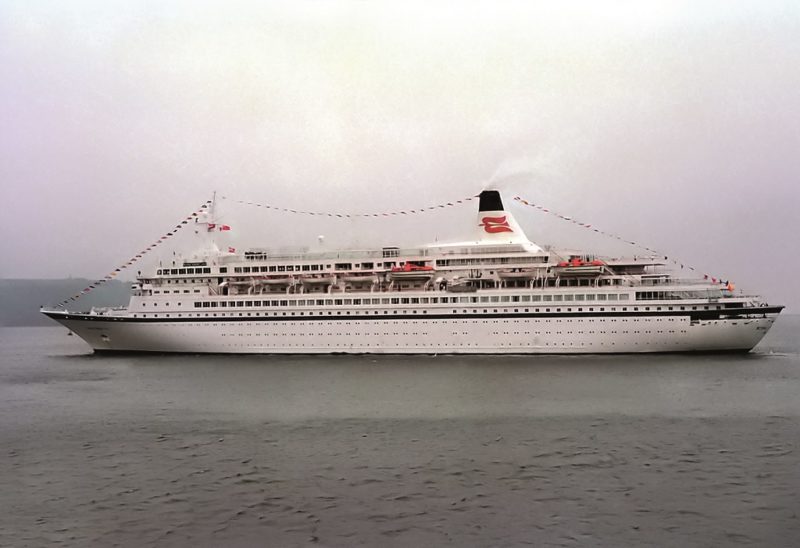
The former Royal Viking Sky was then in October 2005 sold to Fred. Olsen Line to become their Boudicca alongside Black Watch, ex Royal Viking Star. The former Royal Viking Sea had been laid up in late 2001 as Norwegian Star 1 by Star Cruises at their purpose built cruise terminal at Port Klang, her name having been given to a new larger cruise ship. She was under charter from the Norwegian finance company Actinor, and was then sub-chartered for three years to Shanghai based Crown Investment and renamed Crown as a gambling ship cruising between Shanghai and Cheju. However, this came to an abrupt end in November 2002, and she was then sold in 2004 to Albatros Shipping Ltd., Nassau with V Ships as managers and renamed Albatros. She was chartered to Phoenix SeeReisen of Germany and became the least altered of the trio, with the majority of the public rooms remaining in their original configuration. She was given a turquoise blue funnel with a white seagull in flight over a yellow sun, and a blue stripe along her white hull, and was brought up to a high standard of luxury.
The same could not be said for Black Watch and Boudicca. On both ships, the Lounge and Buffet on Marquee Deck had been replaced with additional passenger cabins, while the Observation Lounge above the bridge remained. The full length of Bridge Deck was now occupied with passenger cabins, while the ship’s officers had been scattered around the ship to alternative cabins. The aft part of the very large Dining Room on Black Watch had been converted to two smaller restaurants and an additional lounge, the chapel had been converted into three staterooms, and a fitness centre and spa added on the top deck. Boudicca then had sixteen more cabins than her sister, and the changes were even more radical than on Black Watch. The Dining Room had been broken up into four separate restaurants, with the double height theatre converted into additional staterooms and a fitness centre on Atlantic Deck. Black Watch had a cinema while Boudicca did not.
The eight decks on Black Watch and Boudicca were named as Sun Deck, Marquee Deck (the deck with the Observation Lounge), Bridge Deck, Lido Deck, Lounge Deck with most of the public rooms, Main Deck, Atlantic Deck, and Marina Deck. Lounge Deck on Black Watch was updated in late 2009 with a new stylish bar, a buffet area, and a casual dining area and garden. All of the trio were re-engined during 2005 by the Blohm & Voss yard at Hamburg to replace their four ageing 9-cylinder Wartsila Sulzer diesels. Black Watch was at the yard in May and June for a 57 day refit and received four new MAN-B&W 7-cylinder diesels developing 19,036 bhp and new gearboxes and propellers to give a cruising speed of 19 knots. Boudicca underwent the same refit at the end of the year, while Albatros received four new 6-cylinder Wartsila diesels of 23,656 bhp (15,840 kW) manufactured in Zwolle in Holland at the same yard during November and December to give a cruising speed of 21 knots and she re-entered service on 22nd December. Their new engines gave them many more years of service for the remainder of their long careers. The trio had two forward thrusters for berthing and turning while entering and leaving port, and did not normally take tugs.
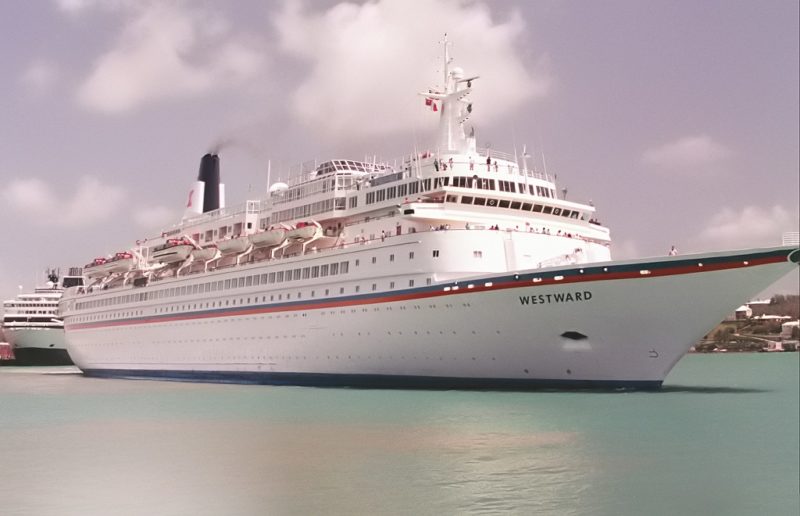
Despite the numerous changes in accommodation and vessel names during their long careers, the Royal Viking trio remained immensely popular with their cruising clientele. Albatros, ex Royal Viking Sea, cruised in the German market, and Black Watch and Boudicca on short and long cruises for Fred. Olsen Line. Black Watch and Boudicca operated many and varied cruises to the Caribbean, Amazon, Mediterranean, Red Sea, Canary Islands, Norwegian North Cape, Baltic, Greenland and Iceland. Boudicca made shorter cruises from Southampton, Greenock, Liverpool, Rosyth, Portsmouth and the Tyne of up to 25 days duration, and made one longer cruise of 35 days duration each January to the Caribbean or the Amazon.
The famous Royal Viking trio also featured on several postage stamps of Pitcairn Island, Tristan da Cunha and the Isle of Man during their long careers. We will now take a closer look at the Royal Viking Line trio when they were known as Black Watch, Boudicaa and Albatros during the final part of their careers.
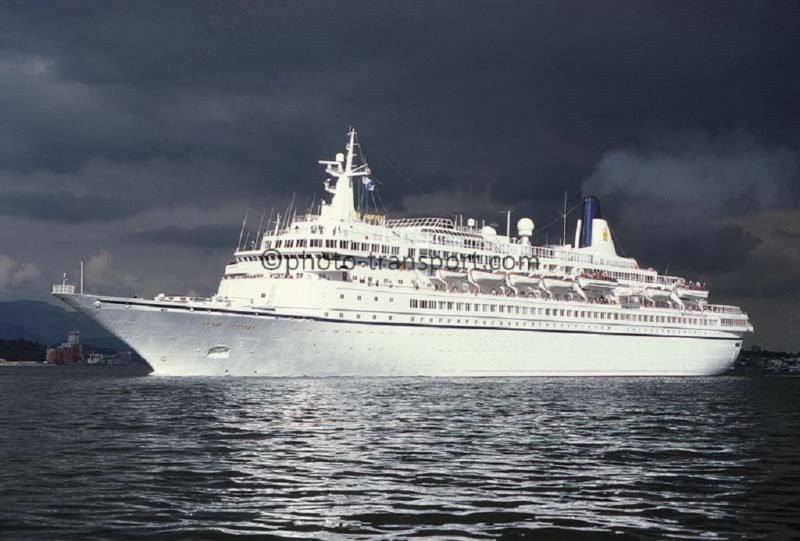
BLACK WATCH
The third Black Watch joined Fred. Olsen Cruises at the end of 1996 in the shape of the former Royal Viking Star of 28,670 grt built in 1972 but lengthened at Bremerhaven in 1981. She initially made a number of long range cruises, including Pacific crossings and worldwide cruises as she had been built with enough storage space for food and provisions and could range worldwide. This luxurious cruise ship began life when launched on 12th May 1971 by Mrs Thor Heyerdahl, wife of the leader of the Kontiki expedition into the Pacific, at the Wartsila yard in Helsinki as Royal Viking Star, the first of a trio of sisters for Royal Viking Line, the most luxurious cruise line of that time.
As mentioned earlier, the trio had cost $67.5 million to build after the line was set up as a joint project between the American businessman Warren Titus, responsible for the marketing of the cruises, and the three Norwegian shipping companies of Bergen Line D/S, Nordenfjeldske D/S, and A. F. Klaveness. The cruise ship sisters were Royal Viking Star for Bergen Line, which later became Black Watch, Royal Viking Sky for Nordenfjeldske D/S, which later became Boudicca, and Royal Viking Sea for A. F. Klaveness, with their ‘shakedown’ cruises in 1972/73 from Bergen to the Tyne. One of the notable features of the trio was a ‘wraparound’ Observatory Lounge underneath the navigating bridge, furnished with sofas, mirrors and a baby grand piano arranged around a rectangular trunkway for the cabling from the navigating bridge instrumentation.
Royal Viking Star entered service on 26th June 1972 with the interior public rooms designed by Norwegian and Danish designers to be as spacious as possible e.g. the Dining Room was able to take all 539 passengers at one sitting and had high ceilings, and the cinema doubled as a theatre. The dimensions of the trio were length overall including a raked bow of 583.0 feet, moulded beam of 82.6 feet, and draft of 24.7 feet, and they were measured at 21,848 grt. They were twin screw and powered by four Wartsila Sulzer 9ZH40/48 diesel engines to give a cruising speed of 21 knots. Royal Viking Star was lengthened by 91.0 feet in 1981 at the A. G. Weser yard in Bremerhaven to 674.1 feet by a new mid-body insertion to increase her passenger complement to 758 passengers with a crew of 435.
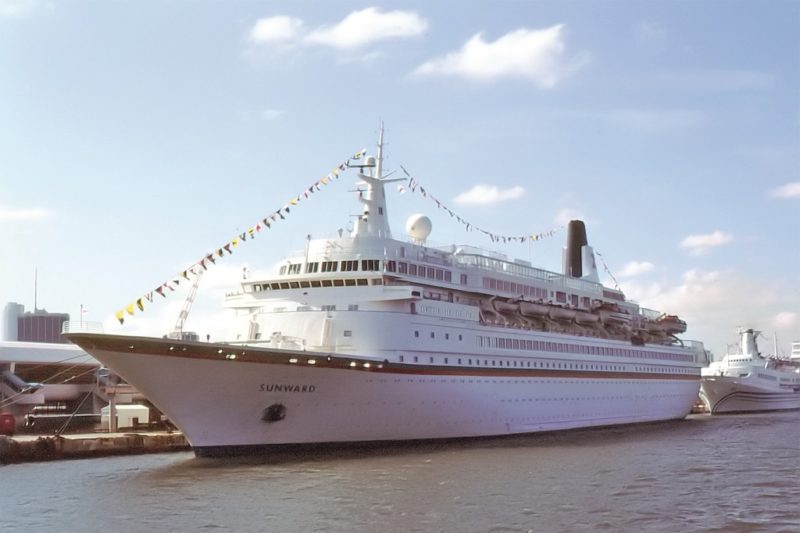
Klaveness of Oslo dropped out of the three original partners of Royal Viking Line in 1975, when their vessel was acquired jointly by Bergen Line and Nordenfjeldske D/S. An American investor group signed an agreement in principle in May 1984 to purchase all three cruise ships of Royal Viking Line for $240 million, but the sale did not go through, and ownership of the trio was then acquired by Kloster Cruises A/S of Oslo, parent company of Norwegian Caribbean Line (NCL). In April 1991, Royal Viking Star was transferred from Royal Viking Line to Norwegian Caribbean Line (NCL) and renamed Westward and used for cruising from New York to Bermuda and the Caribbean. She was renamed Star Odyssey in April 1994 on transfer to the NCL subsidiary Royal Cruise Line for Mediterranean cruising, and joined her sister Royal Viking Sea, which had sailed as Royal Odyssey since 1991. Unfortunately, this subsidiary was sold off by NCL in October 1996 as it was undergoing financial difficulties, and the former Royal Viking Star was then sold a month later to Fred. Olsen and renamed Black Watch.
Black Watch entered service for Fred Olsen on 15th November 1996, with her eight decks for passengers, out of a total of ten decks.
She suffered engine problems when off Marmaris in Turkey on 14th February 1997 and spent two weeks at Malta Drydocks undergoing repairs until early March 1997. She experienced mechanical problems on 3rd December 2002 with one of her two main engines out of action and with propeller issues. She returned at slow speed to Southampton and arrived two days behind schedule, with changes to the following cruise ports of call.
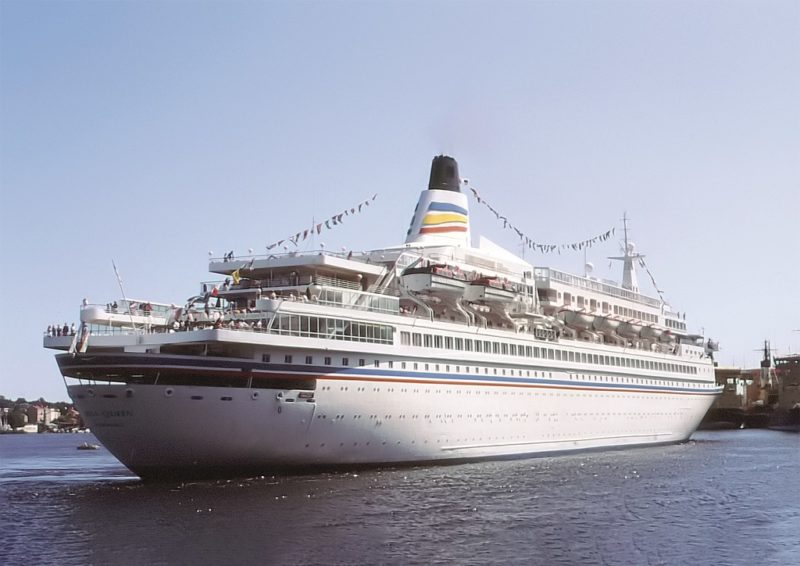
She began her 2003 cruise season with a 72 day cruise around South America, with summer cruises then to the North Cape, Canary Islands, Cape Verde Islands, Azores and to the Western Mediterranean. The Sulzer engines had completed 33 years of service by April and May 2005 when they were replaced by four M.A.N. 7L32/40 diesel engines of 14,000 kilowatts power at the Blohm and Voss yard in Hamburg to give a cruising speed of 22 knots. The new engines and the twin KaMeWa controllable pitch propellers gave an extra knot of speed to enable her to keep to schedule if delayed on worldwide cruises e.g. to Manaus on the Amazon and on Central American cruises, as well as positional Transatlantic voyages to the Caribbean at the beginning of the winter season and back to Mediterranean and Europe for summer cruising. Black Watch and Black Prince of 1966 often cruised to the Canary Islands on similar schedules that included calls at Agadir, Casablanca and Funchal. Despite a novovirus outbreak on Black Watch in September 2013 during a cruise to Scandinavia, she remained a very popular ship.
Two passengers and a crew member fell into the sea on 29th October 2008 while the ship was berthed at Bilbao, when the gangway moved after mooring ropes had failed, resulting in all three being hospitalized until their injuries were stabilised. On 9th February 2014, when 50 miles off Tierra del Fuego (Cape Horn) she suffered steering gear failure and remained there until the gear was repaired so that she could continue her Round the World cruise. A male passenger had been lost overboard a few days earlier when the ship was off the southern Brazilian coast between Rio de Janeiro and Montevideo. The body was sighted floating, and a rescue boat was launched but could not retrieve the body due to high winds and waves of over ten feet in height.


Black Watch caught fire on 1st July 2016 while sailing from Funchal on Madeira to Ponta Delgada in the Azores. She was 260 miles from Funchal with the fire in the auxiliary engine room having put three of her seven generators out of action resulting in a loss of light in most cabins and public rooms. The cruise was cancelled by her owners and all passengers were flown home to the U.K. from Madeira by private charters. All passengers were fully compensated with a full refund plus a 20% credit for all onboard expenses on a future cruise. The damage took some time to repair, and her next cruises were also cancelled.
Black Watch sailed from Southampton on 12th November 2018 and called at Lisbon, Madeira and St. John’s on Antigua and Roseau on Dominica before arriving at Bridgetown on Barbados on 26th November. She then sailed on a long 39 day Pacific fly/cruise from Barbados to Sydney (NSW), and called at several ports in Venezuela and Colombia and then transitted the Panama Canal before calling at well over a dozen beautiful Pacific islands before reaching Sydney (NSW) on 31st December 2018 for the illuminations of the New Year celebration. During 2019 and the first quarter of 2020, she made 37 ocean cruises, mostly of ten to fourteen days duration, together with a 28 day cruise from Liverpool to the Adriatic and Dalmatia coast, and a 24 day cruise from Dubai to the ancient cities of the Middle East, and later celebrated New Year’s Day 2020 in the Canary Islands.
Black Watch made eight cruises from Southampton during the first quarter of 2020 to the North Cape of Norway, to Spain, Portugal and Funchal on Madeira, and to the Canary Islands before sailing from Liverpool on 26th March 2020 on a fourteen day cruise to Funchal and the Azores. Black Watch was then laid up with sister Boudicca in the Firth of Forth after the outbreak of the COVID-19 virus pandemic. On 13th April 2020, eight members of her crew tested positive for the virus and were taken off the ship. On 21st August 2020, Fred. Olsen cruises announced that both Black Watch and Boudicca had been sold for use as accommodation ships for workers at Tuzla shipyard in the Sea of Marmara in Turkey. Boudicca was later sold in April 2021 for breaking up and was beached at Aliaga on 17th May 2021 with dismantling begun on 10th July 2021. The Black Watch was renamed Odin in April and at the time of writing is moored off Gujarat.

BOUDICCA
Royal Viking Sky – Royal Viking Line 1973-1991
Sunward – Norwegian Caribbean Line 1991-1992
Birka Queen – Birka Line 1992-1993
Golden Princess – On charter from Birka Line to Princess Cruises 1993-1996
Superstar Capricorn – Star Cruises 1996-2004
Hyundai Kumgang – Charter to Hyundai Marine 1998-2001
Superstar Capricorn – Star Cruises 2001-2004
Grand Latino – Iberocruceros 2004-2005
Boudicca – Fred. Olsen Cruises 2005-2020
Edi – Final voyage to breakers 2021

Royal Viking Sky was lengthened in October 1982 by 91.0 feet by the A. G. Weser yard at Bremerhaven in the same way as her sister Royal Viking Star by the insertion of a new mid-body to give a new total of 402 cabins for 805 passengers with a crew of 435. She was re-engined in December 2005 by the Blohm and Voss yard in Hamburg with four M.A.N./B & W 7L32/40 diesel engines in the same manner as her sister Black Watch earlier in that year, and it was interesting that the third sister Royal Viking Sea was also re-engined by the same yard during the same year while cruising for Phoenix Seereisen as Albatros. Boudicca is named after the leader of the Iceni tribe, with the Iceni Room as one of the many public rooms on Lounge Deck.
The cruise programme of Boudicca after an inaugural cruise from Dover on 22nd February 2006 to the Canary Islands was mostly cruising from the U.K. ports of Tyne, Leith and Liverpool to the Baltic, North Cape and Canary Islands and Funchal, with at least one Western Mediterranean cruise from the Tyne each year. She participated in the ‘Four Freds’ gatherings at Bergen in 2015 and towards the end of that year she underwent a dry docking in Germany when 22 balcony cabins were added and she received the new Fred Olsen charcoal grey hull livery topped by a bold red stripe. Repainting of the hulls of Black Watch, Balmoral and Braemar then followed by early 2016.
Boudicca was present at the ‘Four Freds’ meeting in Cadiz in 2018, before sailing on from Cadiz to Ibiza, Valletta, Heraklion in Crete and passing through the Suez Canal to arrive at Aqaba on 19th September 2018. She then cruised down the Red Sea to Salalah in Oman as well as Muscat and Khasab in Oman and Doha in Qatar and Abu Dhabi in the United Arab Emirates, arriving on 3rd October 2018. She then cruised to Gujarat in India, Mumbai, Mormugao in Goa, Kochi and Kerala in India, and on to Colombo, arriving on 17th October 2018. She then returned to Dover on 13th February 2019 via the same ports except for calling in addition at Safaga in Egypt.
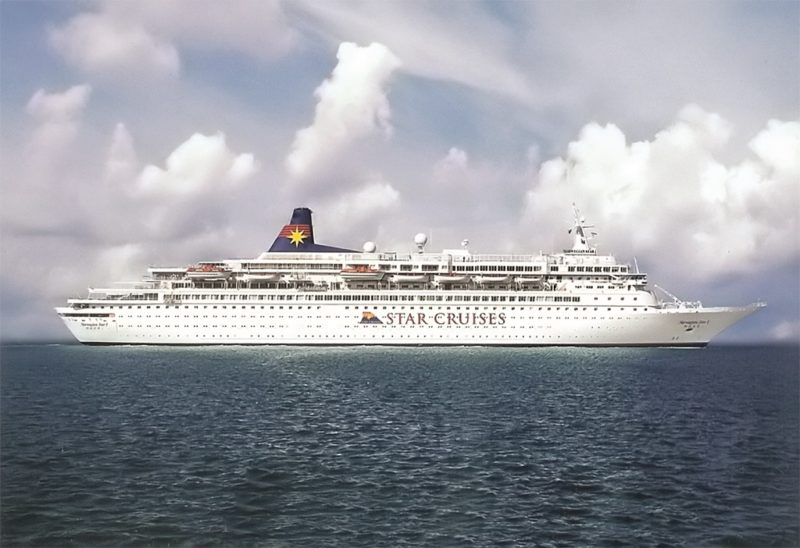
The busy cruising programme of Boudicca during 2019 included a four day Valentine Day cruise from Dover to Amsterdam and Antwerp, two eight day cruises from the Tyne to see the ‘Northern Lights’ in February, a fourteen day cruise from Dover in March to the Canary Islands, and an eight day ‘mystery’ cruise from Dover in March with the passengers only told of their destinations after sailing, a seven day cruise from Dover to see the Spring flower fields of Holland in April as well as exploring Portugal on a nine day cruise and to the scenic fjords of Norway in the same month from Dover. Boudicca then cruised in May on a 22 day cruise to the Amalfi coast viewing the picturesque but extremely ‘vertical’ cliff resort of Positano from the sea, and on to Civitavecchia for Rome and Livorno for Florence in Tuscany.
Boudicca then operated cruises from the U.K. in summer 2019 before she made the longest ever voyage made by a Fred. Olsen cruise ship of 168 days leaving Dover on 3rd October. The ports of call were:-
Dover, La Coruna, Funchal, Santa Cruz de Tenerife, Las Palmas de Gran Canaria, Mindelo and Praia (Cape Verde Islands), Ascension Island (circumnavigation), St. Helena, Walvis Bay and Luderitz (Namibia), Cape Town, Port Elizabeth, Richards Bay, Comoro Islands, Nosy Be (Madagascar), Victoria (Seychelles), Male (Maldives), Colombo, Port Blair (Andaman Islands), Phuket, Sabang (Sumatra), Singapore, Semarang, Lombok Island, Komodo Island, Tanjung Benoa (Bali), Broome, Fremantle, Albany, Penneshaw (Kangaroo Island), Melbourne, Hobart, Sydney, Brisbane, Townsville, Cairns, Aiotau, Madang and Wewak (PNG), Ambon (Indonesia), Komodo Island, Tanjung Benoa (Bali), Singapore, Phuket, Yangon (Myanmar), Colombo, Kochin, Mormugao, Mumbai, Gujarat, Dubai, Khasab, Muscat and Salalah (Oman), Aqaba, Ashdod, Limassol, Heraklion (Crete), Piraeus, Valletta, Palma (Majorca), Cartagena, Malaga, Leixoes and home to Dover for an arrival on 19th March 2020.
The final fate of Boudicca is described in the history of Black Watch above. Fred. Olsen Cruises today operate as an independent cruise line and is very proud to operate their four cruise ships on worldwide cruising amongst many much bigger competitors with a greater share of the world cruise market. The four cruise ships are Balmoral, built in 1988 as Crown Odyssey by the Meyer Werft yard at Papenburg in Germany, Braemar built in 1993 as Crown Dynasty by the Union Naval de Levante yard in Spain, and the twin funnelled sisters Bolette and Borealis, built in 2000 and 1997 as Amsterdam and Rotterdam for Holland America Line by Fincantieri in Italy. Bolette made three cruises in January 2022, a 14 day cruise to the Canary Islands, a 12 day cruise to Andalusia, and a 14 day cruise to view the Northern Lights in Northern Norway. Borealis was cruising in much warmer waters in the same month, on a 36 day cruise to the Caribbean and South America.
ALBATROS
Albatros had originally been a worldwide luxury cruise ship as Royal Viking Sea for the elegant Royal Viking Line, but under Phoenix Seereisen she mainly undertook Baltic, Norwegian, Mediterranean and Black Sea cruises for 830 passengers with a crew of 340. She also went on an annual Round the World voyage to ports in Asia, Australia, New Zealand, South Africa, South America, Canada and New England in the U.S.A. She also made Panama Canal transits, Caribbean cruises, and Suez Canal transits, with also Transatlantic repositioning voyages between the European and Caribbean areas of cruising. Phoenix Seereisen had been set up in Bonn in Germany in 1988 using the chartered Russian liner Maxim Gorkiy built in 1969 from the Black Sea Shipping Company. In 1993, the former Cunard liner Sylvania built in 1957 was chartered from V Ships of Monaco for ten years and was renamed as the first Albatros.
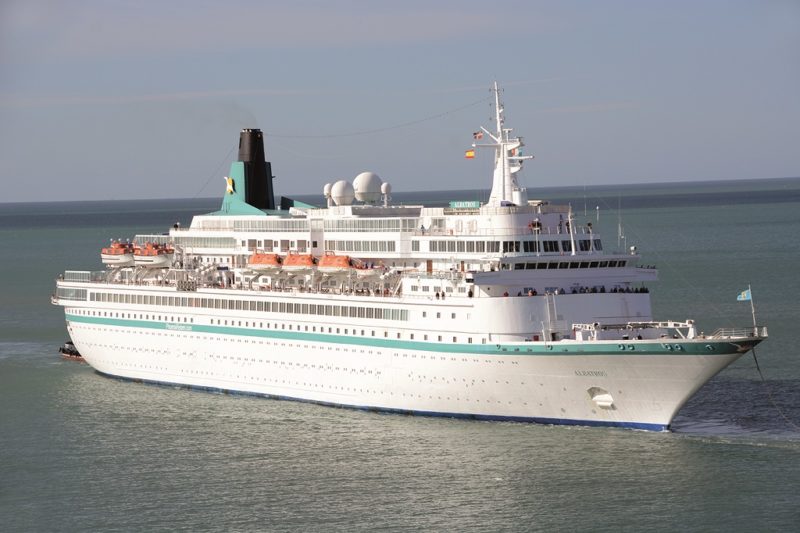
The second Albatros, ex Royal Viking Sea, began her charter to Phoenix Seereisen offering German speaking passengers a wide range of cabins from low to high prices, and a la carte dining menus in the two spacious Pelikan and Mowe dining rooms with high ceilings. A very wide range of entertainment was offered in the two deck Pacific show lounge seating 500, and passengers could also enjoy the Karibik Lounge, Kopernicus Bar, Casablanca Bar, Harry’s Bar and Disco, Atlantik Bar and Lounge, Wellness and Fitness Centre, Beauty Salon, Spa, Sauna, Steam Baths, Golf Garden, table tennis, shuffleboard, whirlpool, swimming pool, boutique, internet centre, and photographic shop and gallery. The Upper Deck swimming pool had a white albatross painted on the blue bottom of the pool.
While in the Pacific on a Round the World voyage on 5th February 2017, she rescued the crew of a sinking Tongan fishing boat, whose crew had run out of drinking water over three days previously. Albatros on one of her 2017/18 cruising voyages arrived for a weekend stay at the coal port of Richards Bay to the north of Durban in South Africa. She arrived at Harwich on 25th September 2017 for a Round Britain cruise, but during this cruise season, her diesel engines broke down on several occasions while on passage, and was one of the reasons why the aging cruise liner was later taken out of service. She was registered in Nassau, a great cruising port that she also visited on various cruises to the Caribbean. She had 420 cabins ranging from inside cabins with no outside views in a tiny ten square metres of space, to a balcony outside suite with seventeen square metres of space, to the top of the range forward looking suite below the navigating bridge known as the Captain’s Suite of sixty square metres of space. The pricing of all of her cabins varied in a bewildering 42 different grades of cabin for example there were nine Penthouse suites with a separate bedroom and living area and a private balcony, and also the spacious Herman Cortes Suite, all with different prices.
The COVID-19 worldwide pandemic resulted in all of the Phoenix Seereisen fleet returning to port at Bremerhaven by June 2020, the last being Artania built back in 1984 as Royal Princess for Princess Cruises, and later sailing as Artemis between 2004 and 2011. Artania was the last cruise ship in the world to be laid up when she arrived from Fremantle and Indonesia on 8th June 2020 at Bremerhaven.
The deteriorating prospects for old cruise ships saw Albatros sold in early October 2020, with a total of her 34 onward cruises cancelled from that date. These included cruises from Bremerhaven to the Canary Islands and Norway, and from British ports to Iceland and Greenland, her summer 2021 Mediterranean cruises, and a long 99 day Round the World 2021 cruise, and a similar long 122 day cruise from Monaco scheduled for 2022.
Instead, the 47 year old Albatros sailed from an anchorage at Le Havre on 21st October 2020 bound for the Suez Canal and the Red Sea Egyptian resort of Hurghada to become a static hotel ship anchored just off one of the many beaches of the resort. She arrived at Hurghada on 9th November 2020 in the ownership of Pick Albatros Hotels and Resorts Egypt, a related subsidiary of her former German owners. Two aqua parks and several hotels in Hurghada, Sharm el Sheikh and Marsa Alam were part of the holiday portfolio of her new owners. Albatros remained at Hurghada from November 2020 through to July 2021.
The old liner was then sold for breaking up on the beaches of Alang at Bhavnagar in India, and she bunkered at Jeddah during a last half day call and was renamed by shortening her name to ‘Tros’ for her final sea passage to Alang, where she arrived on 27th July 2021 at an anchorage off the scrapping beaches. Phoenix Seereisen then began their 2022 cruising season in April with four older cruise ships in Amadea, built in 1991 as Asuka, sailing on a 12 day cruise from Nice to Valletta, Agios Nikolaos, Patmos, Corfu, Split and Trieste, and Artania, built in 1984, sailing on a 14 day cruise from Trieste to Kerkyra, Agios Nikolaos, Rhodes, Bodrum, Cesme, Istanbul, Santorini, Argostoli and back to Trieste. Amera, built in 1988 as Royal Viking Sun for Royal Viking Line and later sailing as Prinsendam for Holland America Line, sailed from Hamburg in the same month for a 21 day cruise to Honfleur, Bordeaux, Lisbon, Funchal, Ponta Delgada, Horta, Praira da Victoria and back to Falmouth and Bremerhaven. The chartered cruise ship Deutschland, built in 1998, sailed on a ten day cruise from Bremerhaven to the Thames at Greenwich, Poole, Honfleur, Rouen, Antwerp, Rotterdam, Amsterdam and back to her base at Bremerhaven.
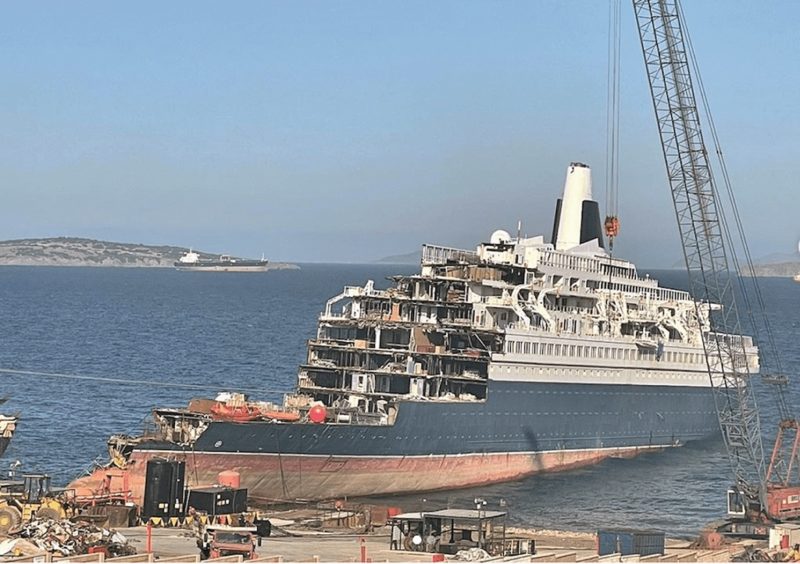
POSTSCRIPT
Royal Viking Line remained with headquarters in California for over twenty years until the luxury cruise brand was split up in 1994 when Kloster Cruises encountered severe financial problems. Cunard Line purchased the beautiful and well designed fourth ship of the fleet, Royal Viking Sun, and continued to operate her as a special luxury cruise segment of Cunard Line. The luxury brand name was then acquired by Carnival Cruise Line of Miami, and following a merger with Seabourn Cruise Line, the brand name and the Sea Goddess cruise fleets were consolidated into Seabourn Cruise Line.
A fifth cruise ship was also completed for the luxury Royal Viking Line brand. This was the boutique cruise ship Royal Viking Queen of 9,961 grt and completed in May 1992 by the Schichau Seebeckwerft yard in Germany with accommodation for 212 passengers in 106 cabins, a crew of 124 and a service speed of 18 knots from diesel engines of 7,280 kW via twin propellers. She later was renamed Queen Odyssey, and Seabourn Legend when the Royal Viking Line brand became part of Seabourn Cruise Line. In 2015, she was sold out of the Carnival cruise empire to become Star Legend of Windstar Cruises.

Despite all of the vicissitudes encountered by the famous Royal Viking Line trio of Royal Viking Sea, Royal Viking Star and Royal Viking Sky, they remained very popular with international cruise passengers over the very long period of almost fifty years. There were periodical health problems with onboard outbreaks of Legionnaire’s disease and Novovirus sickness, but it was the much more serious and fatal Covid-19 Coronavirus that eventually brought the trio to the end of their useful careers.
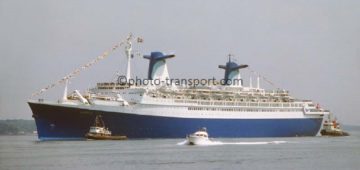



Comments
Sorry, comments are closed for this item